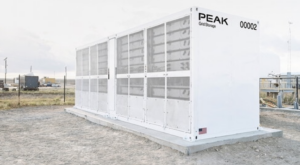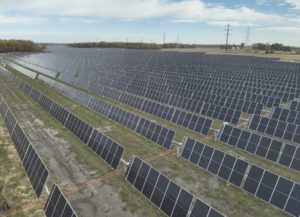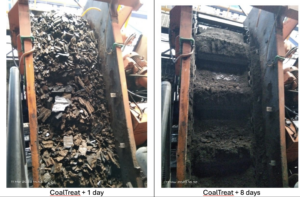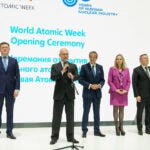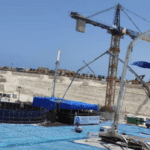
In a strategic move to reduce its heavy dependence on Russian natural gas, Belarus has successfully completed its first nuclear power plant (NPP). The Belarusian NPP, featuring two VVER-1200 reactors, now provides about a third of the nation’s electricity needs and represents a major step toward energy diversification, earning it recognition as a 2024 POWER Top Plant award winner.
The Republic of Belarus is a landlocked country in Eastern Europe. It is bordered by Russia to the north and east, Ukraine to the south, Poland to the west, and Lithuania and Latvia to the northwest. Belarus covers an area of about 207,595 square kilometers (km 2, about the size of Minnesota), 40% of which is forested. Its population was about 9.156 million as of Jan. 1, 2024, according to the country’s official website. Minsk, the largest city and nation’s capital, is home to 21.8% of the population; about 78% of the total population is urban, while 22% is rural.
Belarus was not blessed with abundant energy resources. In 2018, only 15% of the country’s energy demand was met by domestic production, making Belarus one of the least energy self-sufficient countries in the world. Nearly all electricity generation that year (97% or 39 TWh) came from natural gas, supplied mainly by Russia. Notably, Belarus is an important part of Russia’s gas transit corridor to Western Europe, and matters related to natural gas transit, such as infrastructure, system operations, tariff structure, and technical services, are established in a bilateral agreement with Russia’s Gazprom.
Diversifying the Energy Mix
Yet, Belarus has long sought to lessen its reliance on Russian natural gas. The World Nuclear Association reports that in mid-2006, the Belarusian government approved a plan for the construction of an initial 2,000-MWe nuclear power plant (NPP) in the Mogilev region of eastern Belarus. This was expected to provide electricity at half the cost of that from Russian gas and to provide some 30% of the country’s electricity by 2020 at a cost of about €4 billion (January 2008 estimate).
After expressions of interest from international reactor vendors were invited, Russia’s Atomstroyexport emerged as the most likely partner from a list of four suppliers for the two 1,000-MWe units because the others either did not provide all the information required or could not build the plant according to the desired timeline. Operation of the first unit was initially imagined in 2016 and the second in 2018, and two further units were proposed for operation by 2025.
In November 2007, a presidential decree defined the organizations responsible for preparing for the construction of the country’s first NPP, and budgeted money for engineering and site selection. The candidate sites, according to the World Nuclear Association, were Krasnopolyansk and Kukshinovsk (both in the Mogilev region), and Ostrovets in the Grodno region. Ostrovets, 23 km from the Lithuanian border and 55 km from Vilnius, was chosen in December 2008, despite protests from Lithuania.
In June 2009, the Belarusian government announced that Atomstroyexport would be the general contractor, with Russian and Belarusian subcontractors. “On July 18, 2012, the General Contract for the construction of a nuclear power plant was signed,” a spokesperson for the Belarusian NPP told POWER. “Several subcontractors worked on the construction of the Belarusian NPP. Five of them—Belenergostroy, Rossem, Trust No. 8, Gomelpromstroy, and Grodnopromstroy—are the main ones.”
Gen III+ Technology
The units constructed at Ostrovets are VVER-1200/AES-2006 plant designs. They are specifically the V-491 version, which was developed by St. Petersburg Atomenergoproekt on the basis of the AES-91 design developed for China and successfully deployed at Tianwan. The units each have a design net capacity of 1,110 MWe.
According to ROSATOM, Russia’s state atomic energy corporation, the safety philosophy embodied in the VVER-1200/AES-2006 is unique among reactors on the market in deploying a full range of both active and passive systems to provide fundamental safety functions. Its safety systems are reportedly able to handle complicated situations that go beyond traditional design basis accidents. ROSATOM says all new VVER-1200 plants including the Belarusian NPP have design features that fully account for lessons learned from the Fukushima disaster. Notable safety features include having long-term cooling capability of the reactor core without electrical power; long-term decay heat removal that does not rely on primary ultimate heat sinks such as the sea, river, or cooling towers; and protection of reactor containment integrity with dedicated systems after a core meltdown accident.
60-Year Service Life
The design service life of the reactor pressure vessel in the VVER-1200/AES-2006 plant is 60 years. Several measures have been taken to achieve that duration, which include limiting nickel content in welds; limiting impurities in base metal and welds; decreasing the ductile-to-brittle transition temperature of the nozzle area shell material to –35C; and increasing the vessel diameter, which reduces neutron flux at vessel walls. Notably, ROSATOM says the main coolant piping is designed to meet all necessary conditions of the “leak-before-break” concept, including material properties, stress analysis, in-service inspections, and leak monitoring.
The steam generators employed in the VVER-1200 are horizontal (Figure 1) and use a “corridor” layout for the heat-exchange tubes in the tube bundle. The horizontal design means the steam generators do not face such problems as primary water stress-corrosion cracking, fouling, and denting, according to ROSATOM. It says several VVER-440 plants have had steam generators in operation for more than 35 years with no corrosion of heat exchange tubes requiring tube plugging. The steam generator design, which has had incremental improvements over the years, is expected to match the 60-year service life of the reactor pressure vessel.
 |
|
1. VVER-1200 units utilize a horizontal steam generator design. One of the Belarusian steam generators is shown here being delivered. Courtesy: ROSATOM |
The heat transfer surface of the steam generator consists of 10,978 stainless steel tubes with a 16-millimeter (mm) diameter and 1.5-mm wall thickness. ROSATOM says the tubes and their support structures are very robust when compared with those typically used in vertical pressurized water reactor (PWR) steam generators.
The heat exchange tubes are arranged in a U-shaped bundle. The corridor layout of the tubes has 22 mm vertical and 24 mm horizontal spacings. The tube bundle slopes downward 20 mm over the full length to provide proper drainage of tubes. The tubes are mounted by welding the ends to the inside surfaces of the main coolant inlet and outlet collectors.
VVER reactor plants have always used high-volume pressurizers. ROSATOM says this assures a high level of reactor safety, owing to the large coolant inventory in the primary circuit. In the VVER-1200 design, an additional line of controlled water injection to the steam space is included, which allows even better pressure control under transients.
The reactor core contains 163 fuel assemblies. Reactor output is controlled using 121 control rods, as well as with burnable neutron absorber in the fuel rods and by adjusting the boric acid concentration in the primary circuit water. In the VVER-1200 design, hexagonal fuel assemblies are used with 13 spacer grids (including an anti-vibration support) located with a gap of 340 mm. The height of fuel column 3.73 meters and the fuel is enriched up to 4.95%.
Project Details
At the height of construction of the Belarusian NPP facilities, more than 8,000 people were involved. All of them were qualified and experienced workers, according to the plant spokesperson.
The project went smoothly for the most part. However, in July 2016, while workers were moving the Unit 1 reactor pressure vessel, it slipped out of its sling and hit the ground. Although it was reportedly not damaged, ROSATOM replaced the vessel at the request of project overseers. Asked to elaborate on the event, the plant spokesperson said, “During cargo slinging, the subcontractor made deviations from the instructions, and the load was skewed when lifting it. As a result, the reactor vessel slid along the lines and hung diagonally in contact with the ground. At the moment it touched the ground, the main weight of the reactor vessel—more than two-thirds—was held by the crane. The Interdepartmental Commission for the Construction of a Nuclear Power Plant in the Republic of Belarus decided to change the reactor vessel at the Belarusian NPP.”
Still, the plant was reportedly completed on time and on budget. Unit 1 entered commercial operation on June 10, 2021, and Unit 2 followed on Nov. 1, 2023. “The construction of the Belarusian NPP was completed in full in accordance with the project and schedule of construction and installation work,” the spokesperson said. Today, more than 2,700 people work at the Belarusian NPP. “The staff of the nuclear power plant has been formed, trained, and has confirmed its qualifications more than once,” the spokesperson reported.

Game-Changing Results
The Belarusian NPP performed well in 2023. Unit 1 recorded an annual load factor of 78.9% and Unit 2 achieved a load factor of 84.6%, albeit in only two months of commercial operation. “Against the backdrop of the energy crisis, when other states are just starting to implement national nuclear programs, our country has already created its own nuclear infrastructure, the Belarusian NPP is working for the economy and bringing a tangible effect,” the plant spokesperson said. “The operation of two power units of the Belarusian NPP allows us to significantly reduce Belarus’ dependence on hydrocarbon fuels.”
The launch of the nuclear power plant reportedly opened up new opportunities for Belarus and its national economy, and made it possible to more actively develop other areas, such as the production of electric vehicles. “This large-scale project is of historical significance for our country,” the spokesperson said. “Belarus has received a stable, environmentally friendly source of energy, which will cover a third of its domestic electricity needs. Until recently, a significant part of it was produced from natural gas, the reserves of which Belarus does not have. Therefore, the focus is on alternative energy and the most advanced technologies.”
POWER congratulates Belarus and all the people who worked on the Belarusian NPP project. Their efforts are worthy of recognition, specifically, in the form of a 2024 POWER Top Plant award.
—Aaron Larson is POWER’s executive editor.



